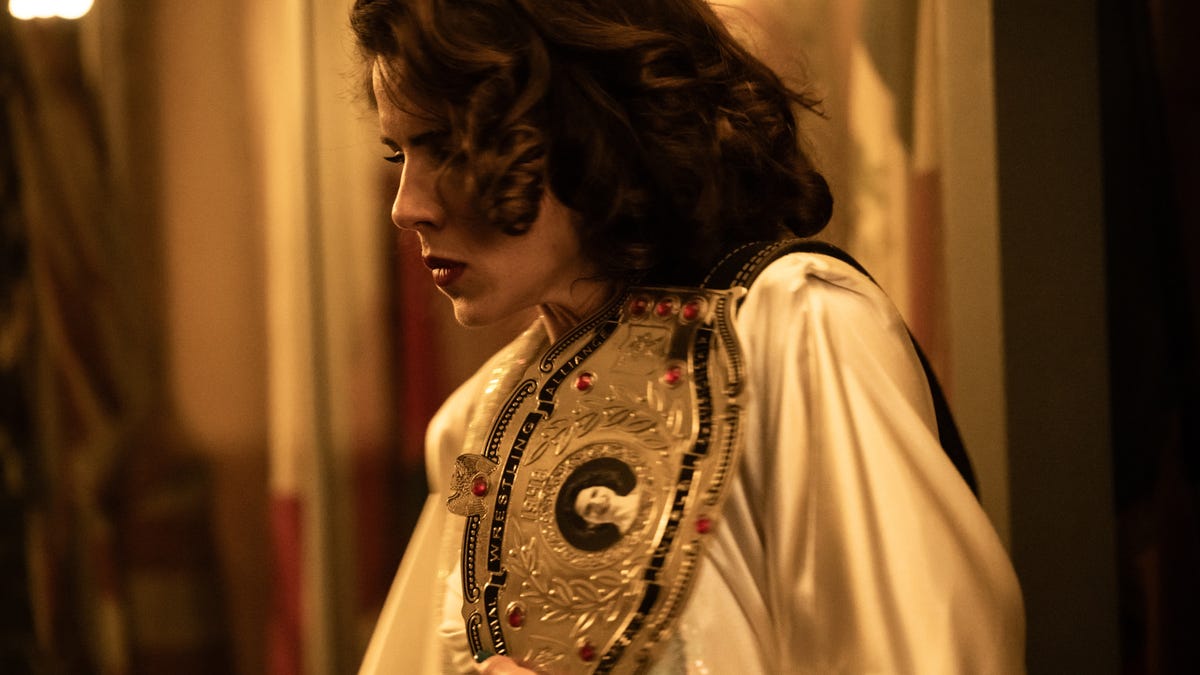‘Queen of the Ring’: Wrestling icon Mildred Burke gets a biopic
Emily Bett Rickards stars as women’s wrestling pioneer Mildred Burke in the sports drama “Queen of the Ring,” also starring Josh Lucas.
Spoiler alert! We’re discussing the ending of the sports biopic “Queen of the Ring” (in theaters now), so beware if you want to go in cold.
Google Mildred Burke and you’ll find vintage pictures of the pro wrestling icon showing off her impressive biceps.
Those photos gave Emily Bett Rickards inspiration not only for what she needed to look like to play the pioneering athlete in the biopic “Queen of the Ring” but also a way into her personality.
“Mildred put on this muscle in a time when it was not in vogue,” Rickards, 33, says of Burke, the first million-dollar female athlete and champion wrestler who was a major draw from the 1930s to the mid-1950s. “There’s a lot more women in the gym now, but at the time, women were not muscular. She wanted her femininity to coincide with this physical strength.”
Join our Watch Party! Sign up to receive USA TODAY’s movie and TV recommendations right in your inbox.
So all the chicken breast Rickards ate and all the weights she lifted were worth it, the actress adds. “Putting on the muscle was important for the physicality of her. But more so than that, it actually helped me find out who she was, because that’s how she operated in the world. She’s flexing in all her pictures because that was her showwomanship, that was her claim to fame.”
Burke laid the foundation for modern champs like Becky Lynch and Toni Storm (who appears in “Queen of the Ring” alongside other actual wrestlers). Rickards talks about what’s real and what’s fiction in the movie based on Jeff Leen’s book “The Queen of the Ring: Sex, Muscles, Diamonds, and the Making of an American Legend”:
Did Mildred Burke really wrestle men?
In the movie and in real life, Millie (born Mildred Bliss on Aug. 5, 1915) was a single mom working at a diner in the ‘30s when she met wrestling manager Billy Wolfe (played by Josh Lucas) and bugged him to show her the ropes. On her first day of training, he had a man body-slam her to scare her off – she turned around and slammed him. “I was lifting dudes three times my size!” Rickards says of her wrestling scenes. “A lot of the time when you’re picking up someone, they’re doing most of the work. It’s wrestling, but it’s an art form and it’s so cool.”
Because women wrestling other women was illegal in many states at the time, Wolfe turned Burke into a traveling carnival attraction, named “the Kansas Cyclone,” who would take on guys in the audience and give them fits. “They didn’t believe that this woman in front of them stood a chance, and that’s their fault and their problem because she showed them that she could,” Rickard says.
Did the real Mildred Burke marry her manager Billy Wolfe?
Wolfe rounded up a league of women to wrestle alongside Millie, who fought for equal pay with the male wrestlers she knew she could outdraw. She married Wolfe to make sure she had a financial stake in their business, and even dealt with his cheating and womanizing, but they wound up divorcing in the early ‘50s, which adversely affected Millie’s finances and wrestling career.
“She did the best that she could but ultimately her downfall was not knowing the inner workings of business because she wasn’t allowed in the room,” Rickards says
Did Mildred Burke really beat her much-bigger foe?
In wrestling, every great babyface needs an equally good heel, and Burke had that in June Byers, aka “the Texas Tornado” (who was also Wolfe’s daughter-in-law). The real Byers was bigger in stature than Burke, so powerhouse Kailey Latimer was cast as June opposite Rickards because “it was supposed to be impossible for Mildred to beat this woman,” Rickards says.
The movie’s climax involves the controversial 1954 bout in Atlanta between the two, which turned into a “shoot” match instead of a worked one – or, in wrestling parlance, a real physical fight instead of a scripted throwdown. The rousing film version ends with Millie keeping her championship belt with a no-contest decision. In real life, the ending was a bit hazier – while Burke believed she was the winner, the Atlanta Athletic Commission awarded the title to Byers.
Rickards finds what happened afterward fascinating: Burke traveled to Japan to pioneer women’s wrestling there, plus “we end our story right as the age of television is taking off,” the actress says. “And unfortunately, that is why Mildred gets forgotten. That is really at the fault of Billy Wolfe, who didn’t believe that television was going to be a large thing for wrestling but clearly that did not go as he planned.”

Leave a Reply